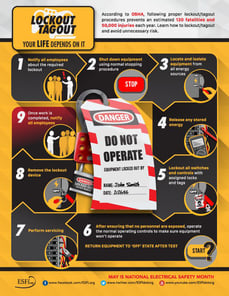Lockout/Tagout is more than just putting a red lock on the main electrical disconnect to a machine or part of a machine. There are 7 very important steps you must do when putting Lockout/Tagout in place:
Seven steps for shutdown
NOTIFY – Notify all affected employees that you are going to be conducting a lockout/tagout.
PREPARE – Before you begin, be sure you know all the types of energy involved, hazards presented by energy, and how to control the energy.
SHUTDOWN – Turn off machine or equipment.
ISOLATE - Isolate machine or equipment from its energy source(s). (For example, turn off main circuit breaker.)
LOCKOUT – apply your lock. Be sure that it holds the isolating device in the “off” or “safe” position.
RELEASE - Release stored energy. Relieve, disconnect, restrain, block, or otherwise ensure, that all energy sources – electrical, mechanical, hydraulic, compressed, etc. – are de-energized.
VERIFY – Try the on-off switch or other controls to be sure the machine won’t start. Return the switch to the “off” position.
Your Lockout is Complete
What exactly does Lock out Tag out apply too?
Lock out Tag out applies to all energy sources: kinetic, chemical, potential, thermal, electrical, radiation, where all facilities and yards, including any and all contractors working in facilities / yards. Lock out Tag out applies whenever the servicing, maintenance of machinery or equipment involved in the unexpected energization, start-up of machinery/equipment or when a release of stored energy could occur which could cause injury to employees.
Forms of Energy
Electrical - electrical panels, generator, lighting systems, etc.
Mechanical - flywheels, blades, fans, belts, etc. (energy of moving parts)
Potential - suspended loads, compressed air, electrical capacitors, coiled springs, chemical reactions, etc. (stored energy that can be released during work)
Hydraulic - presses, rams, cylinders, cranes, forklifts, etc.
Pneumatic - lines, compression tanks, tools, etc.
Thermal - steam, hot water, fire, etc.
Chemical - flammable materials, corrosive substances, vapours, etc.
Some equipment may involve more than one type of energy, and pose unexpected hazards. You must recognize and control conditions such as these. Switches, power sources, controls, pneumatics, hydraulics, gravity-operated sources – all of these must be locked out and appropriately tagged by each worker involved for the lock out tag out procedure to be controlled.



